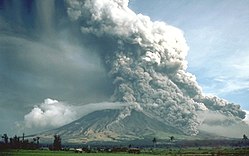Pyroclastic flow
fast-moving concentrated current of hot gas and volcanic matter that moves away from a volcano
A pyroclastic flow, pronounced pie-roh-class-tick, (also known as a pyroclastic density current) is a flow of hot volcanic gas and tephra, during a volcanic eruption. A cloud forms over the current of hot rock. This boiling column of superheated gas, sand, tephra, obsidian, and pumice can reach soaring temperatures of 1,000 °C (1,800 °F) and its average speed ranges from 100 km/h (30 m/s; 60 mph) to 700 km/h (190 m/s; 430 mph).

They are extremely dangerous and can be deadly. A person cannot outrun a pyroclastic flow.